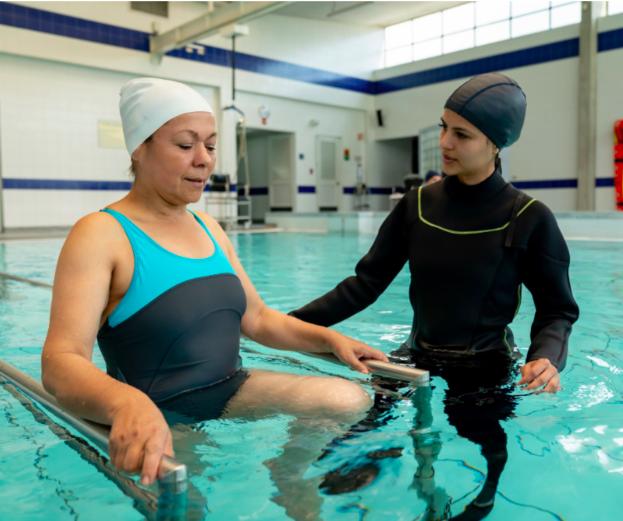Aquatic Rehabilitation is essentially exercising in the water. The unique buoyant and resistive properties of water make it a useful tool for the rehabilitation specialist.

Photo credit: https://www.cohealth.org.au/service/hydrotherapy/
Buoyancy: The buoyancy of water is often used as an assistive tool as it acts against gravity. For example, weight-bearing/walking becomes easier as the depth of water increases. This is perfect for a transition from a non-weight-bearing to weight-bearing status after a lower limb injury. Specific movements and difficulties can be achieved by manipulating the following factors:
- Position or direction of movement in the water
- Water depth
- Lever arm length
- Flotation devices
Hydrostatic Pressure: The pressure exerted by the water at increasing depth accounts for the cardiovascular shifts seen with immersion and for the purported benefit of edema/swelling control. As such, the pool may be a good option for lower extremity edema or joint effusion. This pressure also produces centralization of peripheral blood flow, which alters cardiac dynamics.
Viscosity: The viscous quality of water allows it to be used effectively as a resistive medium because turbulent flow is produced when the speed of movement reaches a critical velocity. For example, using a plow while walking increases the surface area, creating eddies and drag; hence, resistance.
To conclude, because a range of activities from mobility and stretching to resistive and cardiovascular exercise can be performed in the pool, aquatic therapy can progress from the early stage through functional progression. However, the pool program must be balanced by a well-designed land-based program to ensure proper transition back to the land environment.
Physiotherapy is a great place to start, as your physiotherapist will create a personalized land-based program and help determine when the best time to transition into aquatic rehab would be. Our physiotherapists are recognized medical professionals whose degrees allow them to diagnose and treat your injuries. They are an effective and reliable resource for water-based exercises.
Mark Yang
Registered Kinesiologist

Recent Comments